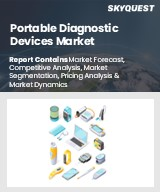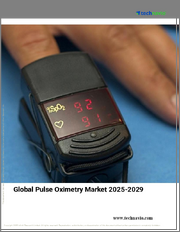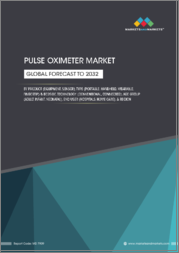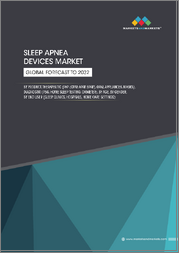
|
시장보고서
상품코드
1834026
대뇌 신체 산소 농도계 시장 : 용도, 최종사용자, 기술 유형, 제품 유형, 채널별 - 세계 예측(2025-2032년)Cerebral Somatic Oximeters Market by Application, End User, Technology Type, Product Type, Channel - Global Forecast 2025-2032 |
||||||
대뇌 신체 산소 농도계 시장은 2032년까지 CAGR 5.77%로 3억 1,078만 달러로 성장할 것으로 예측됩니다.
| 주요 시장 통계 | |
|---|---|
| 기준 연도 2024년 | 1억 9,834만 달러 |
| 추정 연도 2025년 | 2억 983만 달러 |
| 예측 연도 2032 | 3억 1,078만 달러 |
| CAGR(%) | 5.77% |
임상 목적, 핵심 기술, 헬스케어 리더의 전략적 의미를 포괄하는 대뇌 신체 산소 농도계의 종합적인 도입
대뇌 신체 산소 농도계는 국소 산소화를 지속적으로 평가하여 급성기 임상적 판단을 내리는 장면에서 매우 중요한 모니터링 수단으로 부상하고 있습니다. 이 장치들은 기존의 생체 신호 및 침습적 모니터링을 보완하는 것으로, 뇌와 신체 조직의 산소 균형에 대한 정보를 거의 실시간으로 제공합니다. 임상의는 이러한 측정값을 바탕으로 추세를 감지하고, 개입을 유도하고, 시술 중 상황 인식을 향상시킵니다.
기술 발전으로 단일 사이트 모니터링에서 다중 사이트 모니터링 및 뇌-신체 복합 플랫폼으로 기능이 확장되고, 신호 처리 개선으로 모션 아티팩트 및 환경광 아티팩트에 대한 내성이 강화되었습니다. 동시에 임상 가이드라인의 발전과 환자 안전에 대한 관심이 높아지면서 종합적인 수술 전후 및 중증 환자 치료 전략의 일환으로 보조 조직 산소화 모니터링에 대한 관심이 높아지고 있습니다. 이와 함께 병원과 외래 의료 서비스 제공자들은 임상적 유용성, 통합 경로, 비용 효과성에 대한 명확한 증거를 필요로 하는 운영 및 조달 선택에 직면해 있습니다.
이 소개는 이해관계자들이 대뇌 신체 산소농도계를 보다 광범위한 모니터링 포트폴리오에서 대뇌 신체 산소농도계의 위치를 평가하는 데 필요한 배경 지식을 제공합니다. 이 책은 임상적 근거를 체계화하고, 관련 기술 구성요소를 강조하며, 의사결정권자가 채용, 조달, 임상의사 교육 프로그램을 평가할 때 고려해야 할 전략적 사항을 개괄합니다.
기술 집약, 임상 관행의 변화, 상환의 진화, 통합 치료 모델별 뇌 모니터링이 파괴하는 변혁적 변화
대뇌 신체 산소농도계의 상황은 기술적, 임상적, 상업적 역학이 융합되어 변화하고 있으며, 이 세 가지가 함께 채택 경로를 재정의하고 있습니다. 광학 센서 설계, 신호 처리 알고리즘 및 소형화된 전자 장치의 발전으로 다양한 임상 환경에서 보다 강력한 측정이 가능해졌습니다. 동시에 임상의들은 조직 산소화 데이터를 수술 전후 관리, 신경계 중환자 치료, 신생아 지원 프로토콜에 통합하여 이 기술을 임상시험용에서 운영 보조용으로 전환하고 있습니다.
보험 상환 프레임워크와 병원의 조달 우선순위도 진화하고 있으며, 이는 장비의 평가 및 채택 방식에 영향을 미치고 있습니다. 지불자와 관리자들은 점점 더 임상적 영향과 업무상의 이점을 입증할 수 있는 증거를 요구하고 있으며, 제조업체와 임상팀은 결과 지향적 연구와 실제 임상 증거 창출에 집중할 것을 요구하고 있습니다. 또한, 전자의무기록 및 중앙 집중식 모니터링 플랫폼과의 상호운용성 추진으로 기기 설계 및 벤더의 기대치도 변화하고 있습니다.
이러한 혁신적인 변화는 엄격한 임상 검증, 합리적인 통합, 실용적인 도입 지원을 결합할 수 있는 벤더에게 새로운 기회를 가져다주고 있습니다. 마찬가지로, 조달 주기, 임상의의 수용성, 진화하는 규제 당국의 기대에 대응해야 하는 조직에도 도전이 되고 있습니다. 순 효과는 더 복잡하지만, 환자 치료를 분명히 향상시키면서 제한된 업무 예산과 워크플로우에 맞게 기술을 적용하는 데 있어 더 유망한 환경이 될 수 있다는 것입니다.
2025년 미국 관세 개정이 뇌의료기기 공급망, 부품 조달, 가격 역학, 제조업체의 조달 전략에 미치는 영향
2025년 미국의 관세 정책 변경은 의료기기 공급망에 새로운 복잡성을 가져와 조달 결정, 부품 선택, 가격 협상에 영향을 미치게 되었습니다. 세계화된 공급망에 의존하는 의료기기 제조업체의 경우, 관세는 주요 부품의 상륙 비용을 상승시키고, 니어쇼어링(near-shoring)을 촉진하며, 전략적 재고 조정을 촉진할 수 있습니다. 조달팀은 품질과 규정 준수를 유지하면서 이윤을 확보하기 위해 공급업체와의 계약과 TCO 모델을 재검토해야 합니다.
임상의와 병원의 구매 그룹은 공급업체 선정 주기 및 계약 협상을 통해 다운스트림에 영향을 미칠 것으로 보입니다. 자본 및 운영 예산이 빠듯한 병원은 가장 유리한 조달 조건의 장비를 우선적으로 구매하거나, 관세의 영향을 줄이기 위해 현지 유통업체와 제휴할 수도 있습니다. 제조업체는 가격 경쟁력을 유지하기 위해 관세의 영향을 받는 투입물을 줄이기 위해 제품을 재설계하거나, 대체 부품 공급처를 발굴하고, 제조 공간을 변경하는 등의 대응을 할 수 있습니다.
전략적 관점에서 기업은 관세로 인한 혼란을 공급망 복원력을 강화하고 공급업체 생태계를 확장하는 계기로 삼아야 합니다. 계층 간 투명성 강화, 부품 대체를 위한 시나리오 계획, 보다 엄격한 공급업체 인증 기준을 통해 운영 리스크를 줄일 수 있습니다. 동시에, 임상의의 신뢰와 치료의 연속성을 유지하기 위해서는 장비의 가용성 및 지원에 영향을 미치는 변경 사항에 대해 임상 파트너와 명확하게 소통하는 것이 필수적입니다.
애플리케이션, 최종사용자, 기술 유형, 제품 유형, 채널이 채택 및 임상 워크플로우에 미치는 영향을 파악할 수 있는 주요 세분화 인사이트를 제공합니다.
세분화에 대한 인사이트를 통해 임상 응용 분야, 최종사용자 환경, 기술 변형, 제품 형태, 판매 채널이 각각 어떻게 서로 다른 채택 역학과 가치 제안을 촉진하는지 밝혀냈습니다. 용도별로 분석하면, 심장 수술은 지속적인 뇌 및 체성 모니터링이 수술 중 관리를 지원하는 성인 심장과 소아 심장으로, 중환자실은 추세 감지 및 병상에서의 의사결정 지원을 중시하는 성인 ICU와 소아 ICU 사용 사례로, 신생아 신생아 모니터링은 고유한 생리적 고려사항과 센서 배치의 어려움이 있는 만삭아 및 조산아를 구분하고, 신경외과는 국소 관류 데이터가 결정적일 수 있는 뇌졸중 모니터링, 외상성 손상 치료, 종양 절제술에 이르기까지 다양한 분야에 적용됩니다.
최종사용자 관점에서 보면, 외래 수술 센터(독립형과 병원 부속형 모두)는 병원과 비교하여 자본 주기 및 수술량이 다르며, 그 자체로 정부계와 민간계가 다릅니다. 기술 유형 구분에서는 주파수 영역, 근적외선 분광법, 시간 영역의 각 접근법의 차이가 강조되며, 각각 깊이 방향의 민감도, 해상도, 임상적 해석에 있어 트레이드 오프 관계가 있습니다. 제품 유형은 중앙 모니터링용으로 설계된 고정형 시스템과 현장의 유연성을 고려하여 최적화된 휴대용 장치로 시장을 구분하여 임상의의 워크플로우와 유지보수 모델에 영향을 미칩니다.
채널 역학은 조달과 채용을 더욱 형성합니다. 오프라인 판매 채널은 임상적 검증과 교육이 필수적인 통합적 기업 배포에서 여전히 중요하며, 제조업체의 웹사이트 및 타사 전자 소매 업체를 통한 온라인 판매는 소규모 시설과 소비자에게 직접 판매 애플리케이션의 도달 범위를 확장합니다. 이러한 부문이 어떻게 상호 작용하는지를 이해함으로써 보다 정확한 제품 포지셔닝, 임상적 근거를 마련하고, 다양한 임상적, 조직적 배경을 가진 의료 서비스 제공의 실제적 현실에 부합하는 차별화된 서비스 모델을 만들 수 있습니다.
아메리카, 유럽, 중동 및 아프리카, 아시아태평양이 임상 개발, 상환 및 혁신 경로에 미치는 영향에 대한 지역적 관점
지역 역학은 임상 개발, 조달 전략, 규제 경로, 지역 혁신 생태계에 중대한 영향을 미칩니다. 미국 대륙에서는 학계 주도의 임상 검증 연구, 상호 운용성을 우선시하는 통합 병원 시스템, 민간 및 공공 상환 프레임워크에 따른 상업적 전략이 혼합된 채택 패턴을 반영하고 있습니다. 의료진은 수술 전후의 위험 감소 및 신경 보호 사용 사례를 중시하는 경우가 많으며, 이는 제조업체가 제시해야 할 가치 제안을 형성하고 있습니다.
유럽, 중동 및 아프리카의 경우, 다양한 규제와 헬스케어 자금 조달 모델의 다양성으로 인해 각국의 상환 프로세스 및 병원 조달 관행을 고려한 적응형 시장 진입 전략이 필요합니다. 이 지역의 이해관계자들은 비용 효율성과 중앙집중식 구매 협상에 중점을 두는 경우가 많으며, 운영 및 임상적 측면에서 분명한 우위를 보이는 솔루션이 요구되는 기회가 생겨나고 있습니다. 아시아태평양에서는 3차 의료 인프라에 대한 급속한 투자, 신생아 및 중증 환자에 대한 대응 능력에 대한 강조, 현지 제조 및 파트너십을 지원하는 혁신 허브가 기존 공급업체와 신규 진입 업체 모두에게 역동적인 환경을 조성하고 있습니다.
모든 지역에서 지역 기반의 임상적 근거, 문화적으로 적합한 임상의의 참여, 공급망의 견고성 등이 공통적으로 요구되는 필수 과제입니다. 제품 설계, 교육 프로그램, 서비스 모델을 지역 요구 사항과 임상의의 기대에 부합하는 제조업체와 의료 시스템 리더는 다양한 헬스케어 시장에서 채택 장벽을 극복하고 지속적으로 규모를 확장할 수 있는 유리한 입지를 확보할 수 있습니다.
주요 장비 제조업체의 경쟁적 포지셔닝, 연구개발 우선순위, 제품 차별화, 파트너십 접근방식에 대한 기업 차원의 인사이트
기업 차원의 분석에 따르면, 경쟁사와의 차별화는 점점 더 임상적 근거 창출, 시스템 통합, 서비스 대응 전개라는 세 가지 축에 의존하고 있습니다. 주요 제조업체들은 수술 중 의사결정과 환자 결과에 대한 대뇌 및 체성 모니터링의 영향을 입증하기 위해 엄격한 임상 검증 연구와 실제 임상 증거 프로그램에 투자하고 있습니다. 이러한 프로그램은 임상의의 의구심을 해소할 뿐만 아니라, 기기 사용을 관찰 가능한 임상적 평가지표에 연결하여 의료 시스템 및 지불자와의 조달 논의를 지원합니다.
상호운용성과 데이터 통합을 우선시하는 제품 생태계는 중앙 집중식 모니터링 및 분석 기능을 필요로 하는 대규모 병원 네트워크에서 선호되고 있습니다. 전자의무기록에 대한 원활한 연결과 일원화된 대시보드를 제공하는 기업은 도입 시 마찰을 줄이고, 장기적인 정착성을 창출합니다. 이와 함께 교육, 교정, 소프트웨어 업데이트 등 판매 후 지원도 잘 되어 있어, 특히 바이오메디컬 엔지니어링 리소스가 부족한 의료기관의 경우, 경쟁 우위를 점할 수 있습니다.
연구기관, 임상 리더, 채널 파트너와의 협력을 포함한 파트너십 전략은 도달 범위를 확장하고 임상적 가치 제안을 검증합니다. 중소기업이나 신규 진입 기업은 타겟팅된 틈새 애플리케이션, 휴대가 간편하고 저렴한 제품 디자인, 또는 병원의 자본 제약에 맞는 구독 기반 서비스 모델을 제공함으로써 차별화를 꾀할 수 있습니다. 전반적으로, 임상적 엄격성, 기술적 상호 운용성, 신뢰할 수 있는 서비스의 균형을 맞추는 기업이 시험적 사용에서 더 광범위한 임상 통합으로 전환하는 데 가장 유리한 위치에 있습니다.
임상 채택을 가속화하고, 조달을 최적화하고, R&D 우선순위를 조정하고, 임상의의 참여를 강화하기 위해 업계 리더가 취해야 할 실행 가능한 권장 사항
도입과 상업적 성공을 가속화하려는 리더는 임상적 검증, 조달 조정, 임상의의 참여를 연결하는 조정된 전략을 추구해야 합니다. 첫째, 조직 산소 농도 모니터링이 의사결정과 환자 경과를 어떻게 변화시키는지 명확히 하고, 결과에 초점을 맞춘 임상 연구와 실용적인 실제 임상 증거 개념에 투자하는 것입니다. 이러한 연구는 관련성과 신뢰성을 극대화하기 위해 대규모 임상 센터와 협력하여 계획해야 합니다.
둘째, 전자 기록 및 중앙 집중식 모니터링 플랫폼과의 상호 운용성 등 대규모 의료 시스템이 요구하는 통합 요구 사항에 제품 개발을 맞추는 것입니다. 표준화된 교육 패키지 및 원격 기술 지원을 통해 도입을 단순화하여 마찰을 줄이고 보급을 가속화합니다. 셋째, 조달 접근 방식을 재검토하고, 번들 서비스나 서비스형 장치와 같은 유연한 상업 모델을 제공하여 초기 투자 장벽을 낮추고 병원의 예산 편성 주기에 맞춰야 합니다.
또한, 추상적인 성과 지표보다는 실용적인 사용 사례와 판단 기준, 일상적인 워크플로우를 중시하고, 임상의와 마주하는 변화 관리를 우선시합니다. 임상의사 챔피언을 참여시키고, 기존 교육 프로그램에 교육을 포함시킴으로써 지속적 활용을 촉진할 수 있습니다. 마지막으로, 관세 및 부품 리스크를 줄이기 위해 다양한 조달처와 비상 대응 계획을 통해 공급망의 탄력성을 강화합니다. 이러한 행동이 결합되어 임상적 신뢰성, 운영 가능성, 상업적 실행 가능성의 균형 잡힌 현실적인 로드맵이 만들어집니다.
조사 방법 개요 : 조사의 엄격성과 신뢰성을 보장하기 위해 사용한 데이터 소스, 이해관계자 인터뷰, 검증 단계, 분석 프레임워크에 대해 설명합니다.
이 조사에서는 방법론적 엄밀성과 실용적 타당성을 확보하기 위해 이해관계자 1차 조사, 기기 수준의 기술 검토, 2차 증거의 통합을 결합한 다원적 조사 방법을 적용하였습니다. 1차 조사는 임상의, 생물의학 기술자, 조달 책임자, 장비 제조사와의 구조화된 인터뷰를 통해 현장 경험, 채용 장벽, 실행 방법을 파악했습니다. 이러한 인터뷰는 센서 설계, 신호 처리, 사용자 인터페이스, 연결 기능에 초점을 맞춘 직접적인 장비 평가 및 기술 비교를 통해 보완되었습니다.
2차 조사로는 기기의 성능과 임상적 적용을 명확히 하기 위해 동료평가를 거친 임상 문헌, 규제 문서, 진료지침을 체계적으로 검토했습니다. 가능한 한 실제 사례 연구와 병원 도입에 대한 내러티브를 사용하여 가정을 검증하고, 통제된 연구에서 반드시 나타나지 않는 운영상의 문제를 드러내려고 노력했습니다. 데이터 검증 단계에는 인터뷰 결과와 발표된 연구 결과 및 장비의 기술 사양을 상호 참조하고, 불일치를 조정하기 위한 후속 협의를 진행하는 등의 과정이 포함되었습니다.
분석 프레임워크는 질적 주제 분석과 비교 기기 평가를 통합하여 임상의, 조달 팀 및 상업적 리더를 위한 실용적인 인사이트를 제공합니다. 이 조사 방법은 임상적 이해의 깊이와 실제 운영의 세부 사항의 균형을 유지하여 이해관계자들이 임상 채택, 제품 계획 및 공급망 의사결정에 조사 결과를 자신 있게 적용할 수 있도록 돕습니다.
임상적 이점, 운영상의 과제, 정책적 고려사항, 전략적 필수 사항을 연계하여 뇌 산소 측정의 지속적인 채택을 위한 결론적 통합을 가능하게 합니다.
이 요약은 입증된 임상적 유망성과 광범위한 채택의 실제적 현실 사이에 분명한 긴장 관계가 있음을 강조합니다. 대뇌 신체 산소 농도계는 조직 산소화에 대한 고유한 실시간 인사이트를 제공하여 복잡한 수술 및 중환자 치료 중 상황 인식을 향상시킵니다. 그러나 파일럿 프로그램에서 일상적인 사용으로 전환하기 위해서는 목표한 임상적 증거를 창출하고, 원활한 기술 통합을 보장하며, 시설의 우선순위에 따라 조달 모델을 구축하는 것이 중요합니다.
교육, 유지보수, 공급망 복원력과 같은 운영상의 문제는 장기적인 성공을 결정하는 데 있어 임상적 성과만큼이나 중요한 문제입니다. 진료비 보상 명확화 및 모범 사례 기준과 같은 정책적 고려사항은 의료기관의 새로운 모니터링 기법에 대한 투자 의향에 영향을 미칩니다. 벤더와 의료 시스템 모두에게 전략적으로 필요한 것은 기술 역량을 임상의와 관리자의 불확실성을 줄일 수 있는 입증 가능한 임상 워크플로로 전환하는 것입니다.
즉, 임상적으로 검증되고, 상호 운용이 가능하며, 유지보수가 가능하고, 상업적으로 유연한 장비입니다. 이러한 차원에 중점을 둔 조직은 잠재적 유용성과 일상적인 임상적 유용성 사이의 간극을 메울 수 있으며, 운영상의 제약과 진화하는 시장 상황을 관리하면서 환자 치료의 향상을 실현할 수 있습니다.
목차
제1장 서문
제2장 조사 방법
제3장 주요 요약
제4장 시장 개요
제5장 시장 인사이트
제6장 미국 관세의 누적 영향 2025
제7장 AI의 누적 영향 2025
제8장 대뇌 신체 산소 농도계 시장 : 용도별
- 심장 수술
- 성인 심장
- 소아 심장
- 집중치료실
- 성인 ICU
- 소아 집중치료실
- 신생아 모니터링
- 만기 신생아
- 조산 신생아
- 신경외과
- 뇌졸중 모니터링
- 외상
- 종양 절제
제9장 대뇌 신체 산소 농도계 시장 : 최종사용자별
- 외래 수술 센터
- 독립형 센터
- 병원 관련 센터
- 재택 케어 설정
- 병원
- 공립 병원
- 사립 병원
제10장 대뇌 신체 산소 농도계 시장 : 기술 유형별
- 주파수 영역
- 근적외선 분광법
- 시간 영역
제11장 대뇌 신체 산소 농도계 시장 : 제품 유형별
- 고정
- 휴대용
제12장 대뇌 신체 산소 농도계 시장 : 채널별
- 오프라인 판매
- 온라인 판매
- 제조업체 웹사이트
- 서드파티 전자 소매업체
제13장 대뇌 신체 산소 농도계 시장 : 지역별
- 아메리카
- 북미
- 라틴아메리카
- 유럽, 중동 및 아프리카
- 유럽
- 중동
- 아프리카
- 아시아태평양
제14장 대뇌 신체 산소 농도계 시장 : 그룹별
- ASEAN
- GCC
- EU
- BRICS
- G7
- NATO
제15장 대뇌 신체 산소 농도계 시장 : 국가별
- 미국
- 캐나다
- 멕시코
- 브라질
- 영국
- 독일
- 프랑스
- 러시아
- 이탈리아
- 스페인
- 중국
- 인도
- 일본
- 호주
- 한국
제16장 경쟁 구도
- 시장 점유율 분석, 2024
- FPNV 포지셔닝 매트릭스, 2024
- 경쟁 분석
- Medtronic plc
- Masimo Corporation
- Edwards Lifesciences Corporation
- Nonin Medical, Inc.
- ISS, Inc.
- GE Healthcare Technologies Inc.
- Mespere LifeSciences Inc.
- Koninklijke Philips N.V.
- Hamamatsu Photonics K.K.
- HyperMed Imaging, Inc.
- Terumo Cardiovascular Systems Corporation
- Nihon Kohden Corporation
- Ornim Medical Ltd.
- CAS Medical Systems, Inc.
- Opto Circuits(India) Ltd.
The Cerebral Somatic Oximeters Market is projected to grow by USD 310.78 million at a CAGR of 5.77% by 2032.
| KEY MARKET STATISTICS | |
|---|---|
| Base Year [2024] | USD 198.34 million |
| Estimated Year [2025] | USD 209.83 million |
| Forecast Year [2032] | USD 310.78 million |
| CAGR (%) | 5.77% |
Comprehensive introduction to cerebral somatic oximeters covering clinical purpose, core technologies, and strategic implications for healthcare leaders
Cerebral somatic oximeters have emerged as a pivotal monitoring modality in settings where continuous assessment of regional oxygenation informs acute clinical decisions. These devices complement traditional vital signs and invasive monitoring by providing near real-time information about cerebral and somatic tissue oxygen balance, which is critical during high-risk procedures and unstable physiological states. Clinicians rely on these measurements to detect trends, guide interventions, and improve intra-procedural situational awareness.
Technological progress has expanded capabilities from single-site monitoring to multi-site and combined cerebral-somatic platforms, while signal processing improvements have strengthened resistance to motion and ambient light artifacts. Concurrently, evolving clinical guidelines and heightened emphasis on patient safety have increased interest in adjunctive tissue oxygenation monitoring as part of comprehensive perioperative and critical care strategies. In parallel, hospitals and ambulatory providers face operational and procurement choices that require clear evidence of clinical utility, integration pathways, and cost-effectiveness.
This introduction provides the context needed for stakeholders to evaluate where cerebral somatic oximeters fit within broader monitoring portfolios. It frames the clinical rationale, highlights the relevant technological building blocks, and outlines the strategic considerations that decision-makers must weigh when assessing adoption, procurement, and clinician training programs.
Transformative shifts disrupting cerebral monitoring driven by tech convergence, clinical practice changes, reimbursement evolution, and integrated care models
The landscape for cerebral somatic oximetry is being transformed by a convergence of technology, clinical practice, and commercial dynamics that together are redefining adoption pathways. Advances in optical sensor design, signal processing algorithms, and miniaturized electronics are enabling more robust measurements in diverse clinical environments. At the same time, clinicians are integrating tissue oxygenation data into protocols for perioperative management, neurocritical care, and neonatal support, shifting the technology from investigational use to operational adjunct.
Reimbursement frameworks and hospital procurement priorities are also evolving, which affects how devices are evaluated and adopted. Payers and administrators increasingly demand evidence demonstrating clinical impact and operational benefit, prompting manufacturers and clinical teams to focus on outcomes-oriented studies and real-world evidence generation. Additionally, the drive for interoperability with electronic health records and centralized monitoring platforms is changing device design and vendor expectations.
These transformative shifts are creating new opportunities for vendors who can combine rigorous clinical validation, streamlined integration, and practical implementation support. They likewise pose challenges for organizations that must navigate procurement cycles, clinician acceptance, and evolving regulatory expectations. The net effect is a more complex but also more promising environment for technologies that demonstrably improve patient care while fitting into constrained operational budgets and workflows.
Implications of U.S. tariff changes in 2025 for cerebral device supply chains, component sourcing, pricing dynamics, and procurement strategies for manufacturers
Changes to U.S. tariff policy in 2025 have introduced a new layer of complexity into medical device supply chains that affects sourcing decisions, component selection, and pricing negotiations. For device manufacturers that rely on globalized supply networks, tariffs can increase landed costs for critical components, incentivize near-shoring, or prompt strategic inventory adjustments. Procurement teams must reassess supplier agreements and total-cost-of-ownership models to maintain margins while preserving quality and regulatory compliance.
Clinicians and hospital purchasing groups will feel the downstream effects through supplier selection cycles and contract negotiations. Hospitals that operate on tight capital and operational budgets may prioritize devices with the most favorable procurement terms or those that partner with local distributors to mitigate tariff impact. Manufacturers may respond by redesigning products to reduce tariff-exposed inputs, qualifying alternate component sources, or altering manufacturing footprints to preserve price competitiveness.
From a strategic perspective, organizations should treat tariff-driven disruptions as a catalyst to strengthen supply chain resilience and to broaden supplier ecosystems. Enhanced transparency across tiers, scenario planning for component substitution, and more rigorous supplier qualification standards will reduce operational risk. At the same time, clear communication with clinical partners about any changes that affect device availability or support is essential to maintain clinician trust and continuity of care.
Key segmentation insights illuminating how applications, end users, technology types, product formats, and channels influence adoption and clinical workflows
Segmentation insight reveals how clinical application areas, end-user environments, technology variations, product formats, and sales channels each drive distinct adoption dynamics and value propositions. When analyzed by application, cardiac surgery distributions divide into adult and pediatric cardiac contexts where continuous cerebral and somatic monitoring supports intraoperative management; intensive care settings separate into adult ICU and pediatric ICU use cases that emphasize trend detection and bedside decision support; neonatal monitoring differentiates full-term from preterm neonates with unique physiological considerations and sensor placement challenges; and neurosurgery spans stroke monitoring, traumatic injury care, and tumor resection where localized perfusion data can be decisive.
From an end-user perspective, ambulatory surgical centers-both freestanding and hospital-affiliated-have different capital cycles and procedural volumes compared with hospitals, which themselves vary between government and private institutions; home care settings introduce portability and user-friendly interfaces as key product attributes. Technology type segmentation highlights the distinctions among frequency domain, near-infrared spectroscopy, and time domain approaches, each offering trade-offs in depth sensitivity, resolution, and clinical interpretation. Product type divides the market between fixed systems designed for central monitoring and portable units optimized for point-of-care flexibility, with implications for clinician workflow and maintenance models.
Channel dynamics further shape procurement and adoption. Offline sales channels remain important for integrated enterprise deployments where clinical validation and training are integral, while online sales through manufacturer websites and third-party e-retailers expand reach for smaller facilities or direct-to-consumer applications. Understanding how these segments interact enables more precise product positioning, tailored clinical evidence generation, and differentiated service models that align with the practical realities of care delivery across multiple clinical and organizational contexts.
Regional perspectives on how Americas, Europe Middle East & Africa, and Asia-Pacific influence clinical deployment, reimbursement, and innovation pathways
Regional dynamics materially influence clinical deployment, procurement strategies, regulatory pathways, and local innovation ecosystems. In the Americas, adoption patterns reflect a mix of academic-led clinical validation studies, integrated hospital systems prioritizing interoperability, and commercial strategies driven by private and public reimbursement frameworks. Providers often emphasize perioperative risk reduction and neuroprotection use cases, which shapes the value proposition manufacturers must present.
Within Europe, Middle East & Africa, regulatory diversity and varying healthcare financing models require adaptive market-access strategies that account for national reimbursement processes and hospital procurement conventions. Stakeholders in this region frequently focus on cost-effectiveness and centralized purchasing negotiations, creating opportunities for solutions that demonstrate clear operational and clinical advantages. In Asia-Pacific, rapid investment in tertiary care infrastructure, a growing emphasis on neonatal and critical care capabilities, and innovation hubs that support local manufacturing and partnerships create a dynamic environment for both established vendors and new entrants.
Across all regions, localized clinical evidence, culturally appropriate clinician engagement, and supply chain resilience are common imperatives. Manufacturers and health system leaders who align product design, training programs, and service models with regional requirements and clinician expectations will be better positioned to overcome adoption barriers and to scale sustainably within diverse healthcare markets.
Company-level insights on competitive positioning, R&D priorities, product differentiation, and partnership approaches among leading device manufacturers
Company-level analysis indicates that competitive differentiation increasingly rests on three pillars: clinical evidence generation, systems integration, and service-enabled deployment. Leading manufacturers invest in rigorous clinical validation studies and real-world evidence programs to demonstrate the impact of cerebral and somatic monitoring on intraoperative decision-making and patient outcomes. These programs not only address clinician skepticism but also support procurement discussions with health systems and payers by tying device use to observable clinical endpoints.
Product ecosystems that prioritize interoperability and data integration are favored by large hospital networks that require centralized monitoring and analytics capabilities. Companies that provide seamless connectivity to electronic health records and centralized dashboards reduce implementation friction and create long-term stickiness. In parallel, robust post-sale support-covering training, calibration, and software updates-serves as a competitive advantage, particularly for institutions with limited biomedical engineering resources.
Partnership strategies, including collaborations with research institutions, clinical leaders, and channel partners, extend reach and validate clinical value propositions. Smaller or newer entrants can achieve differentiation through targeted niche applications, focused product design for portability or affordability, or by offering subscription-based service models that align with hospital capital constraints. Overall, the firms that balance clinical rigor, technical interoperability, and dependable service are best positioned to move from pilot use toward broader clinical integration.
Actionable recommendations for industry leaders to accelerate clinical adoption, optimize procurement, align R&D priorities, and deepen clinician engagement
Leaders seeking to accelerate adoption and commercial success should pursue a coordinated strategy that bridges clinical validation, procurement alignment, and clinician engagement. First, invest in outcome-focused clinical studies and pragmatic real-world evidence initiatives that articulate how tissue oxygenation monitoring alters decision-making and patient trajectories. These studies should be designed in collaboration with high-volume clinical centers to maximize relevance and credibility.
Second, align product development with integration requirements demanded by large health systems, including interoperability with electronic records and centralized monitoring platforms. Simplifying deployment through standardized training packages and remote technical support reduces friction and accelerates uptake. Third, reassess procurement approaches to offer flexible commercial models, such as bundled services or device-as-a-service constructs, that lower upfront capital barriers and align with hospital budgeting cycles.
Additionally, prioritize clinician-facing change management that emphasizes practical use cases, decision thresholds, and routine workflows rather than abstract performance metrics. Engaging clinician champions and embedding training within existing educational programs will drive sustained use. Finally, shore up supply chain resilience through diversified sourcing and contingency planning to mitigate tariff and component risks. Together, these actions create a pragmatic roadmap that balances clinical credibility, operational feasibility, and commercial viability.
Research methodology overview describing data sources, stakeholder interviews, validation steps, and analytical frameworks used to ensure study rigor and credibility
This study applies a multi-method research approach that combines primary stakeholder engagement, device-level technical review, and secondary evidence synthesis to ensure methodological rigor and practical relevance. Primary research comprised structured interviews with clinicians, biomedical engineers, procurement leaders, and device manufacturers to capture frontline experiences, adoption barriers, and implementation practices. These interviews were complemented by direct device evaluations and technical comparisons focusing on sensor design, signal processing, user interfaces, and connectivity capabilities.
Secondary research included systematic review of peer-reviewed clinical literature, regulatory documentation, and practice guidelines to contextualize device performance and clinical applications. Wherever possible, real-world case studies and hospital implementation narratives were used to validate assumptions and to surface operational challenges that do not always appear in controlled studies. Data validation steps included cross-referencing interview findings with published studies and device technical specifications, and conducting follow-up consultations to reconcile discrepancies.
Analytical frameworks integrated qualitative thematic analysis with comparative device assessment to produce actionable insights for clinicians, procurement teams, and commercial leaders. The methodology balances depth of clinical understanding with practical operational detail, enabling stakeholders to apply findings with confidence to clinical adoption, product planning, and supply chain decision-making.
Concluding synthesis linking clinical benefits, operational challenges, policy considerations, and strategic imperatives to enable durable adoption of cerebral oximetry
The synthesis highlights a clear tension between demonstrated clinical promise and the practical realities of wide-scale adoption. Cerebral somatic oximeters provide unique real-time insights into tissue oxygenation that enhance situational awareness during complex procedures and in critical care. Yet the transition from pilot programs to routine use depends on generating targeted clinical evidence, ensuring seamless technical integration, and structuring procurement models that align with institutional priorities.
Operational issues such as training, maintenance, and supply chain resilience are as consequential as clinical performance in determining long-term success. Policy considerations, including reimbursement clarity and standards for best practice, will influence institutional willingness to invest in new monitoring modalities. The strategic imperative for vendors and health systems alike is to translate technical capability into demonstrable clinical workflows that reduce uncertainty for clinicians and administrators.
In conclusion, durable adoption will favor solutions that marry rigorous evidence with practical execution: devices that are clinically validated, interoperable, serviceable, and commercially flexible. Organizations that focus on these dimensions can bridge the gap between potential and routine clinical utility, delivering improved patient care while managing operational constraints and evolving market conditions.
Table of Contents
1. Preface
- 1.1. Objectives of the Study
- 1.2. Market Segmentation & Coverage
- 1.3. Years Considered for the Study
- 1.4. Currency & Pricing
- 1.5. Language
- 1.6. Stakeholders
2. Research Methodology
3. Executive Summary
4. Market Overview
5. Market Insights
- 5.1. Rising adoption of AI-driven cerebral oximetry analytics for early neurological injury detection
- 5.2. Growing demand for noninvasive multisite somatic oximeters in neonatal and pediatric monitoring
- 5.3. Integration of portable cerebral oximeters with telehealth platforms for remote patient management
- 5.4. Expansion of cerebral oximetry applications in cardiac surgery and critical care settings
- 5.5. Development of disposable sensor technology to reduce cross-contamination and overall costs
- 5.6. Enhanced interoperability of cerebral oximeters with hospital information systems and electronic health records
- 5.7. Surge in regulatory approvals for wearable rSO2 monitoring devices across emerging markets
- 5.8. Advancement of multimodal monitoring combining cerebral oximetry with EEG and hemodynamic data
6. Cumulative Impact of United States Tariffs 2025
7. Cumulative Impact of Artificial Intelligence 2025
8. Cerebral Somatic Oximeters Market, by Application
- 8.1. Cardiac Surgery
- 8.1.1. Adult Cardiac
- 8.1.2. Pediatric Cardiac
- 8.2. Intensive Care Unit
- 8.2.1. Adult Icu
- 8.2.2. Pediatric Icu
- 8.3. Neonatal Monitoring
- 8.3.1. Full-Term Neonate
- 8.3.2. Preterm Neonate
- 8.4. Neurosurgery
- 8.4.1. Stroke Monitoring
- 8.4.2. Traumatic Injury
- 8.4.3. Tumor Resection
9. Cerebral Somatic Oximeters Market, by End User
- 9.1. Ambulatory Surgical Centers
- 9.1.1. Freestanding Centers
- 9.1.2. Hospital Affiliated Centers
- 9.2. Home Care Settings
- 9.3. Hospitals
- 9.3.1. Government Hospitals
- 9.3.2. Private Hospitals
10. Cerebral Somatic Oximeters Market, by Technology Type
- 10.1. Frequency Domain
- 10.2. Near-Infrared Spectroscopy
- 10.3. Time Domain
11. Cerebral Somatic Oximeters Market, by Product Type
- 11.1. Fixed
- 11.2. Portable
12. Cerebral Somatic Oximeters Market, by Channel
- 12.1. Offline Sales
- 12.2. Online Sales
- 12.2.1. Manufacturer Website
- 12.2.2. Third-Party E-Retailers
13. Cerebral Somatic Oximeters Market, by Region
- 13.1. Americas
- 13.1.1. North America
- 13.1.2. Latin America
- 13.2. Europe, Middle East & Africa
- 13.2.1. Europe
- 13.2.2. Middle East
- 13.2.3. Africa
- 13.3. Asia-Pacific
14. Cerebral Somatic Oximeters Market, by Group
- 14.1. ASEAN
- 14.2. GCC
- 14.3. European Union
- 14.4. BRICS
- 14.5. G7
- 14.6. NATO
15. Cerebral Somatic Oximeters Market, by Country
- 15.1. United States
- 15.2. Canada
- 15.3. Mexico
- 15.4. Brazil
- 15.5. United Kingdom
- 15.6. Germany
- 15.7. France
- 15.8. Russia
- 15.9. Italy
- 15.10. Spain
- 15.11. China
- 15.12. India
- 15.13. Japan
- 15.14. Australia
- 15.15. South Korea
16. Competitive Landscape
- 16.1. Market Share Analysis, 2024
- 16.2. FPNV Positioning Matrix, 2024
- 16.3. Competitive Analysis
- 16.3.1. Medtronic plc
- 16.3.2. Masimo Corporation
- 16.3.3. Edwards Lifesciences Corporation
- 16.3.4. Nonin Medical, Inc.
- 16.3.5. ISS, Inc.
- 16.3.6. GE Healthcare Technologies Inc.
- 16.3.7. Mespere LifeSciences Inc.
- 16.3.8. Koninklijke Philips N.V.
- 16.3.9. Hamamatsu Photonics K.K.
- 16.3.10. HyperMed Imaging, Inc.
- 16.3.11. Terumo Cardiovascular Systems Corporation
- 16.3.12. Nihon Kohden Corporation
- 16.3.13. Ornim Medical Ltd.
- 16.3.14. CAS Medical Systems, Inc.
- 16.3.15. Opto Circuits (India) Ltd.



















